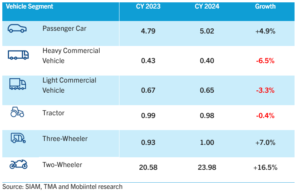The Indian Automotive Market’s Performance
India’s automotive sector, a powerhouse of the economy, has surged ahead to become the third-largest automobile market globally. This dynamic industry, contributing over $200 billion to the economy and accounting for 7.1% of the GDP, is a vital engine of growth, providing employment to more than 40 million people both directly and indirectly.
The year 2024 painted a diverse picture for the automotive sector. Overall production volumes (excluding two-wheelers) saw a modest 3% increase compared to 2023, but the performance across segments was varied. Passenger cars enjoyed steady growth, driven by the soaring demand for SUVs, while commercial vehicles faced a downturn. In contrast, two-wheelers experienced remarkable growth, though tractors and light commercial vehicles remained stagnant
Segment-Wise Performance [volume in million units]

Passenger Cars
The passenger car segment recorded a 4.9% growth, driven by the unrelenting demand for SUVs. Expanding middle-class households and rising disposable incomes particularly in urban areas propelled this growth. However, sales of small cars declined significantly as rising costs outpaced income growth among their primary consumer bases.
Commercial Vehicles
Both heavy and light commercial vehicle (CV) segments faced headwinds, with production volumes dipping by 6.5% and 3.3%, respectively. The slowdown was attributed to election-year uncertainties, reduced freight activity, and heightened competition from the robust three-wheeler segment in the sub-2-ton category.
Tractors
The tractor segment remained stagnant at just under 1 million units, continuing a three-year plateau. However, improved rainfall, higher reservoir levels, and an increase in minimum support prices (MSP) in the latter half of the year signalled a potential revival. Positive rural sentiment offers hope for the future.
Two-Wheelers
Emerging as the strongest-performing segment, two-wheeler sales soared by 16.5%. This rebound was driven by the recovery of rural and Tier 2 markets, coupled with rising aspirations in these regions. However, exports in this segment are yet to pick up pace.
Three-Wheelers
With 7% growth, the three-wheeler segment benefited from rising demand for last-mile connectivity solutions, especially in urban areas, and its affordability compared to light commercial vehicles.
Conclusion
The year 2024 underscored the resilience of India’s automotive industry amid challenges. The sector’s ability to adapt to shifting consumer preferences, macroeconomic trends, and global headwinds positions it for sustainable growth in 2025. As India continues to march toward becoming a leading global automotive hub, investments in technology, infrastructure, and green energy will play pivotal roles in defining its trajectory.
For a deeper dive into these insights, stay tuned for more updates on Mobiintel’s research.

